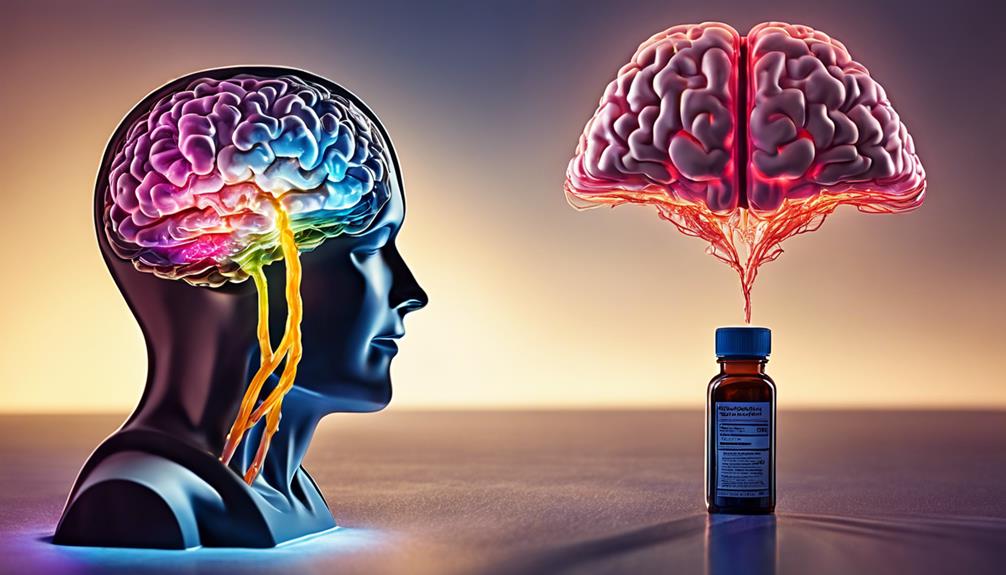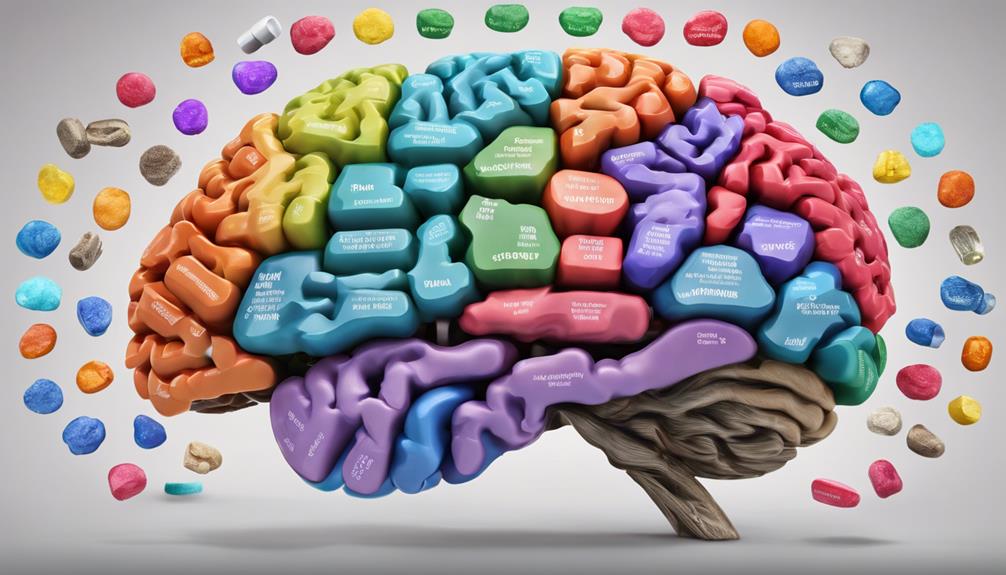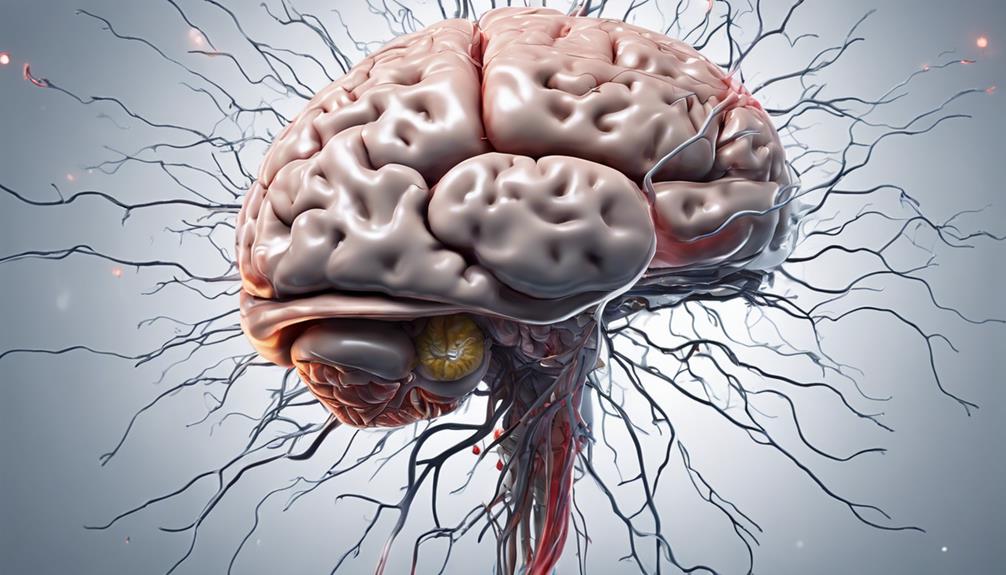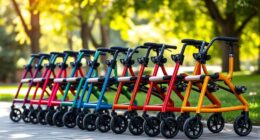When evaluating the top brain supplements for recovery after a stroke, it is crucial to take into account how specific nutrients can significantly influence the healing journey and improve cognitive abilities following a stroke.
Understanding how these supplements work in promoting brain health and aiding in recovery is crucial for optimizing outcomes.
By exploring the benefits of essential vitamins like B6, B12, D, E, and C, along with other key components such as omega-3 fatty acids, one can uncover a wealth of information on how to support the brain's healing journey after a stroke.
Key Takeaways
- Vitamin D crucial for neuroprotection and mood improvement post-stroke.
- Omega-3 aids brain health and reduces stroke risk, enhancing recovery.
- Vitamin B12 vital for nerve cell development and cognitive function post-stroke.
- Vitamin E supports brain health, memory, and cognitive function during recovery.
Essential Vitamins for Stroke Recovery
Essential vitamins play a critical role in stroke recovery, with Vitamin D standing out for its neuroprotective benefits and overall healing support. Adequate levels of Vitamin D are crucial as low concentrations have been linked to worse outcomes post-stroke. This vitamin plays a significant role in reducing inflammation and supporting neuroplasticity, aiding in the brain's ability to rewire and heal after a stroke.
In addition to Vitamin D, other essential vitamins like B12 and B3 are vital for stroke recovery. Vitamin B12 deficiency can lead to increased inflammation, negatively impacting blood vessels and hindering the recovery process. On the other hand, Vitamin B3, also known as Niacin, plays a role in enhancing neuroplasticity, which is essential for recovering from a stroke.
Moreover, probiotics contribute to stroke recovery by supporting the gut-brain axis, which plays a crucial role in overall health and healing post-stroke. Ensuring a well-rounded intake of these essential vitamins can significantly aid in the recovery journey.
Top Omega-3 Fatty Acids Benefits

Omega-3 fatty acids, crucial for brain health and inflammation reduction, offer significant benefits for stroke recovery. These essential fats, commonly found in fish like salmon and nuts, play a vital role in promoting cognitive function and reducing the risk of recurrent strokes. Research indicates that omega-3 fatty acids may enhance neuroplasticity, aiding in the repair and regeneration of brain cells post-stroke. Incorporating omega-3 fatty acids into the diet can support overall recovery and well-being after a stroke. Studies also suggest that these fatty acids could help improve outcomes and reduce the risk of disability in stroke survivors.
- Essential for brain health and reducing inflammation
- Improves cognitive function and lowers the risk of recurrent strokes
- Enhances neuroplasticity for brain cell repair and regeneration
- Supports overall recovery and well-being post-stroke
- May reduce the risk of disability in stroke survivors
Importance of Vitamin D Post-Stroke
Low levels of vitamin D post-stroke have been associated with poorer outcomes, highlighting the importance of adequate supplementation for enhancing recovery. Vitamin D offers neuroprotective benefits crucial for post-stroke rehabilitation. It aids in improving activity levels, balance, independence, and mood following a stroke.
Adequate supplementation is essential not only for supporting bone health but also for potentially enhancing recovery outcomes. Research indicates that vitamin D plays a significant role in safeguarding the brain and nerve cells, which contributes to better recovery after a stroke. Individuals with depleted levels of vitamin D post-stroke may particularly benefit from supplementation to support their overall recovery process.
Ensuring sufficient vitamin D levels post-stroke is vital for both brain health and overall well-being, making it a key component in the recovery journey.
Role of Vitamin B12 in Recovery

After discussing the importance of Vitamin D post-stroke, it's crucial to understand the role of Vitamin B12 in the recovery process and its impact on neurological function and brain health. Vitamin B12 plays a vital role in various aspects of the recovery journey, particularly following a stroke. Here are key points highlighting the significance of Vitamin B12 in the healing process:
- Crucial for Nerve Cells: Vitamin B12 supports the development and maintenance of nerve cells, crucial for cognitive function and recovery.
- Brain Health: Adequate levels of Vitamin B12 are essential for promoting overall brain health, enhancing neurological recovery.
- Healing Mechanisms: Including Vitamin B12-rich foods or supplements in the diet can optimize the body's healing mechanisms post-stroke.
- Neurological Issues: Deficiency in Vitamin B12 can lead to neurological issues obstructing the recovery process.
- Cognitive Function: Vitamin B12 is crucial for healthy red blood cell formation and oxygen transport, which are essential for cognitive function.
Cognitive Support With Vitamin E
Enhancing cognitive function and supporting neuroplasticity, Vitamin E offers valuable potential in aiding stroke recovery through its antioxidant properties. Vitamin E acts as an antioxidant, protecting brain cells from oxidative stress, which is beneficial for stroke survivors. Research indicates that Vitamin E supplementation may enhance cognitive function and memory, crucial aspects of stroke recovery. Additionally, Vitamin E is essential for maintaining overall brain health and promoting neuroplasticity, which is vital for the brain's ability to reorganize and form new connections after a stroke. Including Vitamin E-rich foods such as nuts, seeds, and leafy greens in the diet can further support cognitive function during stroke recovery. It is important to consult a healthcare provider before adding Vitamin E supplements to ensure safe and effective cognitive support during the recovery process.
| Antioxidant Properties | Cognitive Function | Stroke Recovery |
|---|---|---|
| Protects brain cells from damage | Improves memory | Supports neuroplasticity |
Frequently Asked Questions
What Is the Best Vitamin for the Brain After a Stroke?
We believe the best vitamin for the brain after a stroke is Vitamin D. It offers neuroprotective benefits and can enhance stroke recovery outcomes.
This vitamin plays a crucial role in supporting brain health post-stroke. Its influence on neuroprotection and potential to improve recovery make it a top choice for aiding in the rehabilitation process.
Vitamin D's benefits for nerve cell function and overall brain health make it a valuable supplement for stroke survivors.
What Heals the Brain After a Stroke?
We believe that a combination of increased blood flow, oxygen delivery, and neuroplasticity aids in healing the brain after a stroke. These factors allow for the reorganization and formation of new neural connections, supporting recovery.
Proper nutrition, rich in antioxidants, along with physical and occupational therapy play crucial roles in restoring motor function and cognitive abilities post-stroke.
Adequate rest and sleep are also essential for the brain to recover and repair damaged areas.
How Can I Stimulate My Brain After a Stroke?
To stimulate our brains after a stroke, we can engage in cognitive activities, such as puzzles and learning new skills. Physical exercise, like walking or yoga, enhances blood flow and neuroplasticity.
Social interactions and communication promote brain stimulation and emotional well-being. Listening to music, playing instruments, or art therapy activates various brain regions.
Brain training apps can also improve memory and cognitive functions, aiding in post-stroke recovery.
How Do You Restore Blood Flow to the Brain After a Stroke?
When a stroke occurs, restoring blood flow to the brain is crucial for recovery. Medications like tPA can dissolve clots, while mechanical thrombectomy physically removes blockages.
Rehabilitation therapies such as physical and occupational therapy aid in improving circulation. Lifestyle changes like exercise and a healthy diet promote optimal blood flow. Monitoring and managing risk factors like high blood pressure are essential.
Together, these strategies help support the brain's recovery post-stroke.
Conclusion
In conclusion, incorporating essential vitamins like B6, B12, D, E, and C, along with omega-3 fatty acids, can significantly enhance stroke recovery outcomes. These brain supplements provide crucial nutrients to support brain function, immune health, and protection against oxidative stress.
By utilizing these powerful tools, individuals can experience a remarkable improvement in cognitive function and overall well-being post-stroke. Remember, the best brain supplements for stroke recovery can truly be a game-changer in your healing journey.









